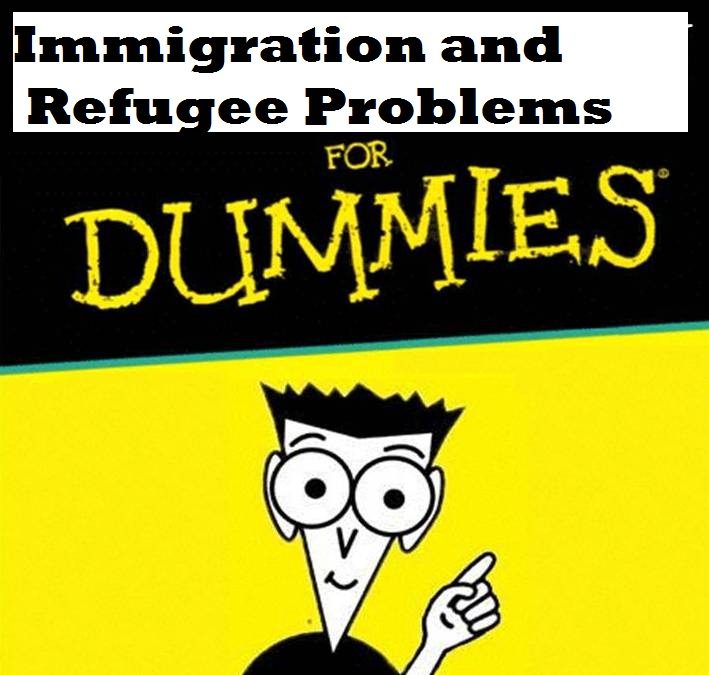By Wallace Bruschweiler & William Palumbo
With the Syrian (so-called) refugee crisis ubiquitous in the headlines, the media has found itself dealing with immigration issues on a daily basis. Unfortunately, extreme confusion abounds. The media’s total inability to draw basic distinctions regarding immigration to the United States, both legal and illegal is harming the public’s ability to digest this important topic. Immigration terms are being thrown around print media, radio, and television that have no relation to the real facts or existing laws.
The following is the dummy’s guide to some of the most important distinctions regarding legal and illegal immigration to the United States. It is sincerely hoped that this will help to end the erroneous reasons and multitude of excuses offered by the media on a daily, almost hourly, basis.
Legal Immigration
Visas
- Visa Waiver Program: For travel and business purposes, this allows visitors to the United States from other specified countries to enter the country without obtaining a visa (based upon reciprocity). There were 38 Visa Waiver countries as of January 2009. Applicants fill out an application via ESTA.us. (Note: Israel is not one of those 38 countries, yet Americans can enter Israel without obtaining a visa.)
- Common Visas:
- K1: For foreign fiancés of Americans. These visas are often abused by foreigners who seek citizenship, and will bribe “fiancés” whom they have no intention of marrying.
- K-3: For foreign spouses of Americans.
- H-1B: For skilled foreign workers. American employers must prove that the foreigner’s qualifications are not readily available domestically.
- F and M: Academic/student visas. See below for common abuses of student visas.
Legal Immigrants
- Green Cards: Holders of Green Cards must not be outside the United States for more than 5 months and 29 days per year. They must also have a legal record. After five years, they are eligible to apply for citizenship. At that time, they must also indicate all the countries they have visited in the previous five years.
Illegal Immigration
- Border crossings: Today, the nation’s two borders (south and north) are equivalent to Swiss cheese. The Border Patrol has been handicapped by the Obama administration. By definition, we know nothing (no names, no photos, no fingerprints) about illegal immigrants who cross our borders unannounced and unchallenged. In the worst case scenario, an illegal immigrant who is caught inside the country will be ordered to leave within 15 days. Against all logic, no check is applied to make sure that he does in fact leave!
- If a person returns to the country illegally after being deported for previously entering illegally, by law that person has committed a felony and should be arrested, sentenced, and jailed.
- Visa overstays: Other than border crossings, many foreigners are in the country illegally because they overstay their visas. For example, student visas are routinely abused in this manner. Why?
- After they are issued, there is no check to ensure that the student is enrolled at the college/university. They may never show up to begin with, or drop out after one, two, or three years.
- After their study program is over, there is no check to ensure that they leave the country as expected.
Refugees
Refugees should not be considered a part of the immigration system, legal or illegal. The Refugee Resettlement program is administered by the federal government (U.S. Department of State) and the United Nations. In the U.S., the program is managed by politically-connected NGO’s (including many who are connected to the Catholic Church), and who receive money per refugee they process.
- Security screenings: The White House claims that each refugee goes through multiple levels of security screenings, including the FBI, DHS, and State Department. However, FBI Director James Comey has warned that “certain gaps” remain in the screening process.
Sanctuary Cities
According to the Center for Immigration Studies, “Across the U.S., there are 340 cities, counties, and states that are considered “sanctuary cities”. These jurisdiction[s] protect criminal aliens from deportation by refusing to comply with ICE detainers or otherwise impede open communication and information exchanges between their employees or officers and federal immigration agents.”
In other words, these are cities, counties, and states where existing federal law is intentionally ignored by local authorities. For a map of these places, click here.
Conclusion
The entry checks for immigrants are sophisticated (ten-finger prints, pictures, and names). But there are no checks whatsoever regarding their exit. Therefore, it is impossible to provide accurate figures on overstays, illegal entries, etc.
The American immigration system is abused through both legal and illegal channels. Because of the complexity of the issue, the media regularly confuses and/or conflates the problems associated with the system. Despite the challenges and complexities, the laws already exist to enforce immigration and ensure the integrity of the system, and in turn keep Americans safe. Special time and effort should be dedicated to develop and implement accurate and feasible exit procedures.

